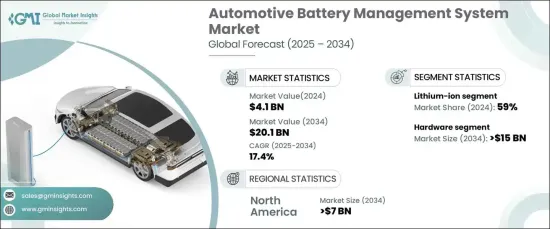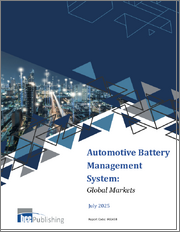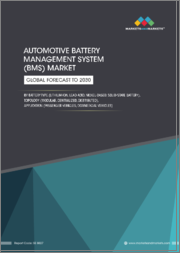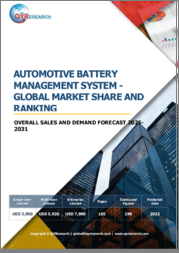
|
시장보고서
상품코드
1665065
자동차 배터리 관리 시스템 시장 기회, 성장 촉진요인, 산업 동향 분석 및 예측(2025-2034년)Automotive Battery Management System Market Opportunity, Growth Drivers, Industry Trend Analysis, and Forecast 2025 - 2034 |
||||||
세계의 자동차 배터리 관리 시스템 시장은 2024년에는 41억 달러로 평가되었고, 2025년부터 2034년까지의 CAGR은 17.4%로 예측되어 큰 성장이 전망되고 있습니다.
전기자동차(EV)의 보급 대수 증가가 이 시장 확대를 촉진하는 주요 요인입니다. 이 성장은 환경 규제 강화, 정부 보조금 및 배터리 기술의 지속적인 발전으로 더욱 촉진됩니다. 지속가능한 운송에 대한 투자도 증가하고 있으며, 인공지능(AI), 사물인터넷(IoT), 예측 분석의 혁신이 차세대 BMS 솔루션 수요를 가속화하고 있습니다.

배터리의 안전성과 성능 향상에 중점을 두어 BMS에 고도의 배터리 감시·보호 집적 회로(IC)를 통합하는 움직임이 가속화되고 있습니다. 이러한 고급 시스템은 배터리의 건전성, 온도, 충전 레벨 등과 같은 중요한 파라미터를 모니터링하고 과충전 및 과열과 같은 위험을 방지하도록 설계되었습니다. EV와 에너지 저장 시스템의 보급이 진행됨에 따라 신뢰성이 높고 고성능의 보호 기술에 대한 수요가 높아지고 있으며, BMS는 안전하고 효율적인 에너지 저장 솔루션을 확보하는데 있어서 매우 중요한 요소가 되고 있습니다.
| 시장 범위 | |
|---|---|
| 시작 연도 | 2024년 |
| 예측 연도 | 2025-2034년 |
| 시작 금액 | 41억 달러 |
| 예측 금액 | 201억 달러 |
| CAGR | 17.4% |
시장은 하드웨어 구성 요소와 소프트웨어 구성 요소로 구분됩니다. 2024년에는 하드웨어 부문이 시장 점유율의 78%를 차지했으며 2034년까지 시장 규모는 150억 달러에 달할 것으로 예상됩니다. 이 성장의 원동력은 에너지 효율, 배터리 보호, 열 관리를 강화하는 마이크로컨트롤러, 센서, 파워 매니지먼트 IC의 진보입니다. 실시간 모니터링이 가능한 소형·경량 구성 요소를 요구하는 움직임은 이 분야의 기술 혁신을 한층 더 가속화해 향후 수년간은 지속적인 확대가 예상됩니다.
배터리 유형별로는 리튬 이온, 납 축전지, 니켈 기반 및 기타 배터리 기술이 시장에 포함되어 있습니다. 리튬 이온 배터리는 2024년 시장 점유율에서 59%를 차지했으며, 앞으로도 우위성을 유지할 것으로 예상됩니다. 뛰어난 에너지 밀도, 긴 수명, 고급 안전 기능으로 EV에 적합한 선택입니다. AI를 활용한 분석, 충전 효율 향상, 비용 최적화 노력은 리튬 이온 시스템용 BMS 기술의 진화를 촉진하여 탁월한 성능과 신뢰성을 제공합니다.
북미는 세계의 자동차 배터리 관리 시스템 시장에서 2024년 시장 점유율의 37%를 차지했고 2034년까지 70억 달러를 창출할 것으로 예측됩니다. 미국 자동차 산업은 전기 이동성으로의 전환이 현저하고 EV의 상승을 지원하는 BMS 솔루션에 대한 수요가 높아지고 있습니다. 이 전환의 주요 촉진요인으로는 엄격한 배출 기준, 정부 인센티브, 지속 가능한 운송에 대한 광범위한 중점이 포함됩니다. AI 통합, 안전기능 강화, 성능 최적화 등 새로운 동향은 이 지역의 전기차 채용을 뒷받침하고 BMS 시장 확대를 더욱 추진하고 있습니다.
목차
제1장 조사 방법과 조사 범위
- 조사 디자인
- 조사 접근
- 데이터 수집 방법
- 기본 추정과 계산
- 기준연도의 산출
- 시장추계의 주요 동향
- 예측 모델
- 1차 조사와 검증
- 1차 정보
- 데이터 마이닝 소스
- 시장 정의
제2장 주요 요약
제3장 업계 인사이트
- 생태계 분석
- 공급자의 상황
- 원재료 공급자
- 부품 제조업체
- 배터리 제조업체
- 시스템 통합
- OEM
- 최종 사용자
- 이익률 분석
- 기술 혁신의 상황
- 특허 상황
- 주요 뉴스 및 이니셔티브
- 규제 상황
- 기술의 차별화 요인
- 고급 데이터 분석과 AI 통합
- 모듈형과 중앙 집중식 토폴로지 비교
- 솔리드 스테이트 배터리 통합
- 무선 통신 기능
- 영향요인
- 성장 촉진요인
- 전기자동차(EV)의 보급이 수요를 견인
- 에너지 효율과 지속가능성에 대한 주목 향상
- 청정에너지 기술을 촉진하는 정부 규제
- 배터리 기술과 에너지 저장의 진보
- 업계의 잠재적 위험 및 과제
- 높은 첨단 BMS 기술 개발 비용
- 기존 차량 아키텍처와의 복잡한 통합
- 성장 촉진요인
- 성장 가능성 분석
- Porter's Five Forces 분석
- PESTEL 분석
제4장 경쟁 구도
- 서론
- 기업 점유율 분석
- 경쟁 포지셔닝 매트릭스
- 전략 전망 매트릭스
제5장 시장 추계·예측 : 구성 요소별(2021-2034년), 10억 달러
- 주요 동향
- 하드웨어
- 배터리 IC
- 배터리 센서
- 기타
- 소프트웨어
제6장 시장 추계·예측 : 배터리별(2021-2034년), 10억 달러
- 주요 동향
- 리튬 이온
- 납산
- 니켈 기반
- 기타
제7장 시장 추계·예측 : 토폴로지별(2021-2034년), 10억 달러
- 주요 동향
- 집중형
- 모듈형
- 분산형
제8장 시장 추계·예측 : 차량별(2021-2034년), 10억 달러
- 주요 동향
- 승용차
- 해치백
- 세단
- SUV
- 상용차
- LCV
- HCV
제9장 시장 추계·예측 : 지역별(2021-2034년), 10억 달러
- 주요 동향
- 북미
- 미국
- 캐나다
- 유럽
- 영국
- 독일
- 프랑스
- 스페인
- 이탈리아
- 러시아
- 북유럽
- 아시아태평양
- 중국
- 인도
- 일본
- 한국
- 뉴질랜드
- 동남아시아
- 라틴아메리카
- 브라질
- 멕시코
- 아르헨티나
- 중동 및 아프리카
- UAE
- 남아프리카
- 사우디아라비아
제10장 기업 프로파일
- ABB
- Analog Devices
- Bird Global
- Bosch
- Continental
- Eatron
- Ficosa
- Infineon
- Johnson Matthey
- LG Chem
- Marelli
- Midtronics
- Nuvation Energy
- NXP
- Panasonic
- Qorvo
- Renesas Electronics
- Sensata
- Texas Instruments
- Toshiba
The Global Automotive Battery Management System Market, valued at USD 4.1 billion in 2024, is poised for significant growth, with a projected CAGR of 17.4% from 2025 to 2034. The rise in electric vehicle (EV) adoption is a key factor driving this market expansion. This growth is further fueled by stricter environmental regulations, government subsidies, and continuous advancements in battery technologies. Investments in sustainable transportation are also increasing, while innovations in artificial intelligence (AI), the Internet of Things (IoT), and predictive analytics are accelerating the demand for next-generation BMS solutions.

The focus on enhancing battery safety and performance is propelling the integration of advanced battery monitoring and protection integrated circuits (ICs) within BMS. These advanced systems are designed to monitor critical parameters such as battery health, temperature, and charge levels, preventing hazards like overcharging and overheating. As the adoption of EVs and energy storage systems continues to rise, the demand for reliable, high-performance protection technologies grows, making BMS a crucial component in ensuring safe and efficient energy storage solutions.
| Market Scope | |
|---|---|
| Start Year | 2024 |
| Forecast Year | 2025-2034 |
| Start Value | $4.1 Billion |
| Forecast Value | $20.1 Billion |
| CAGR | 17.4% |
The market is segmented into hardware and software components. In 2024, the hardware segment commanded a dominant 78% of the market share and is expected to generate USD 15 billion by 2034. This growth is driven by advancements in microcontrollers, sensors, and power management ICs that enhance energy efficiency, battery protection, and thermal management. The push for compact, lightweight components capable of real-time monitoring is further accelerating innovation in this segment, positioning it for continued expansion in the coming years.
In terms of battery type, the market includes lithium-ion, lead-acid, nickel-based, and other battery technologies. Lithium-ion batteries hold a commanding 59% market share in 2024 and are expected to maintain dominance. Their superior energy density, extended lifespan, and advanced safety features make them the preferred choice for EVs. The ongoing evolution of AI-driven analytics, improved charging efficiency, and cost optimization efforts are driving advancements in BMS technologies for lithium-ion systems, ensuring they continue to offer exceptional performance and reliability.
North America automotive BMS market accounted for 37% of the global market share in 2024 and is projected to generate USD 7 billion by 2034. The U.S. automotive industry is experiencing a significant shift toward electric mobility, with growing demand for BMS solutions to support the rise of EVs. Key drivers of this transition include stringent emission standards, government incentives, and a broader emphasis on sustainable transportation. Emerging trends such as AI integration, enhanced safety features, and performance optimization continue to boost the region's adoption of electric vehicles, further supporting the expansion of the BMS market.
Table of Contents
Chapter 1 Methodology & Scope
- 1.1 Research design
- 1.1.1 Research approach
- 1.1.2 Data collection methods
- 1.2 Base estimates and calculations
- 1.2.1 Base year calculation
- 1.2.2 Key trends for market estimates
- 1.3 Forecast model
- 1.4 Primary research & validation
- 1.4.1 Primary sources
- 1.4.2 Data mining sources
- 1.5 Market definitions
Chapter 2 Executive Summary
- 2.1 Industry 3600 synopsis, 2021 - 2034
Chapter 3 Industry Insights
- 3.1 Industry ecosystem analysis
- 3.2 Supplier landscape
- 3.2.1 Raw material suppliers
- 3.2.2 Component manufacturers
- 3.2.3 Battery manufacturers
- 3.2.4 System integrators
- 3.2.5 OEM
- 3.2.6 End users
- 3.3 Profit margin analysis
- 3.4 Technology & innovation landscape
- 3.5 Patent landscape
- 3.6 Key news & initiatives
- 3.7 Regulatory landscape
- 3.8 Technology differentiators
- 3.8.1 advanced data analytics and AI integration
- 3.8.2 Modular vs. centralized topology
- 3.8.3 Solid-State battery integration
- 3.8.4 Wireless communication capabilities
- 3.9 Impact forces
- 3.9.1 Growth drivers
- 3.9.1.1 Increasing electric vehicle (EV) adoption driving demand
- 3.9.1.2 Rising focus on energy efficiency and sustainability
- 3.9.1.3 Government regulations promoting clean energy technologies
- 3.9.1.4 Advancements in battery technologies and energy storage
- 3.9.2 Industry pitfalls & challenges
- 3.9.2.1 High development costs for advanced BMS technologies
- 3.9.2.2 Complex integration with existing vehicle architectures
- 3.9.1 Growth drivers
- 3.10 Growth potential analysis
- 3.11 Porter’s analysis
- 3.12 PESTEL analysis
Chapter 4 Competitive Landscape, 2024
- 4.1 Introduction
- 4.2 Company market share analysis
- 4.3 Competitive positioning matrix
- 4.4 Strategic outlook matrix
Chapter 5 Market Estimates & Forecast, By Component, 2021 - 2034 ($Bn, Units)
- 5.1 Key trends
- 5.2 Hardware
- 5.2.1 Battery IC
- 5.2.2 Battery sensors
- 5.2.3 Others
- 5.3 Software
Chapter 6 Market Estimates & Forecast, By Battery, 2021 - 2034 ($Bn, Units)
- 6.1 Key trends
- 6.2 Lithium-ion
- 6.3 Lead-acid
- 6.4 Nickel-based
- 6.5 Others
Chapter 7 Market Estimates & Forecast, By Topology, 2021 - 2034 ($Bn, Units)
- 7.1 Key trends
- 7.2 Centralized
- 7.3 Modular
- 7.4 Distributed
Chapter 8 Market Estimates & Forecast, By Vehicle, 2021 - 2034 ($Bn, Units)
- 8.1 Key trends
- 8.2 Passenger cars
- 8.2.1 Hatchback
- 8.2.2 Sedan
- 8.2.3 SUV
- 8.3 Commercial vehicles
- 8.3.1 LCV
- 8.3.2 HCV
Chapter 9 Market Estimates & Forecast, By Region, 2021 - 2034 ($Bn, Units)
- 9.1 Key trends
- 9.2 North America
- 9.2.1 U.S.
- 9.2.2 Canada
- 9.3 Europe
- 9.3.1 UK
- 9.3.2 Germany
- 9.3.3 France
- 9.3.4 Spain
- 9.3.5 Italy
- 9.3.6 Russia
- 9.3.7 Nordics
- 9.4 Asia Pacific
- 9.4.1 China
- 9.4.2 India
- 9.4.3 Japan
- 9.4.4 South Korea
- 9.4.5 ANZ
- 9.4.6 Southeast Asia
- 9.5 Latin America
- 9.5.1 Brazil
- 9.5.2 Mexico
- 9.5.3 Argentina
- 9.6 MEA
- 9.6.1 UAE
- 9.6.2 South Africa
- 9.6.3 Saudi Arabia
Chapter 10 Company Profiles
- 10.1 ABB
- 10.2 Analog Devices
- 10.3 Bird Global
- 10.4 Bosch
- 10.5 Continental
- 10.6 Eatron
- 10.7 Ficosa
- 10.8 Infineon
- 10.9 Johnson Matthey
- 10.10 LG Chem
- 10.11 Marelli
- 10.12 Midtronics
- 10.13 Nuvation Energy
- 10.14 NXP
- 10.15 Panasonic
- 10.16 Qorvo
- 10.17 Renesas Electronics
- 10.18 Sensata
- 10.19 Texas Instruments
- 10.20 Toshiba



















